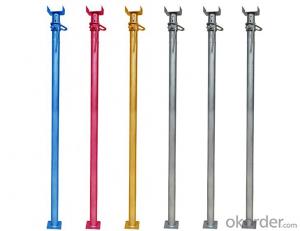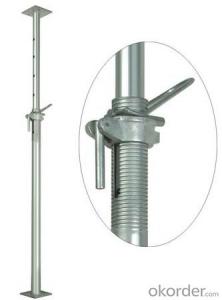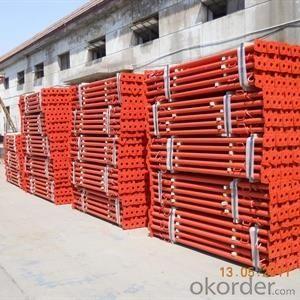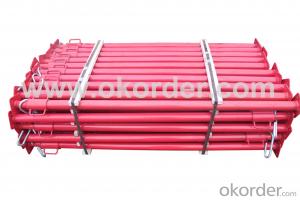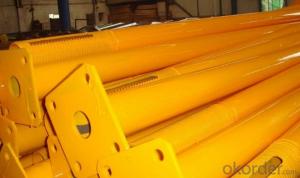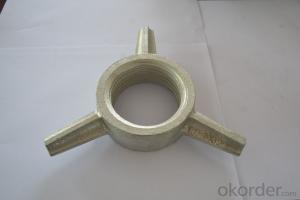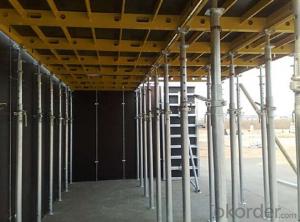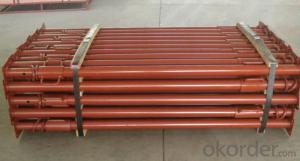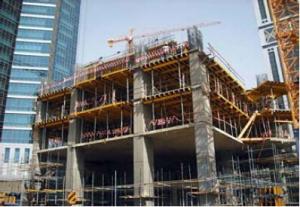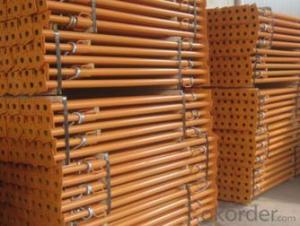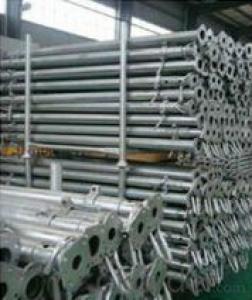Adjustable Steel Props of Scaffolding System
- Loading Port:
- China main port
- Payment Terms:
- TT OR LC
- Min Order Qty:
- 1000 pc
- Supply Capability:
- 1000000 pc/month
OKorder Service Pledge
OKorder Financial Service
You Might Also Like
Product information:
Model Number: GTJ-P003
Name: Q235 High Quality Steel Slab Props
Material: Q235
Thickness: 1.6mm to3mm or as your requirements
Surface Treatment: as per requirements
Standard: use your standard or international standard
Dimension: Light duty 40-48mm, MID Duty 48-56/58mm, Heavy duty 48-60mm
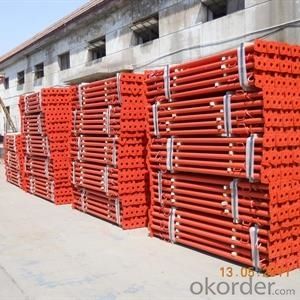
Characteristics:
1. Reliable performance
2. Corrosion resistance
3. Durable finish standards
Functions
It is used for construction supporting, timber, formwork, concrete slab and so on. It is very easy and reliable to use
Why Choose Us
1. We are experienced manufacturer in Hebei with more than 4 years experience and cooperating with more many countries.
2. We supply qualified products which are certified by SGS and ISO9001:2008. Strict QC to make sure your profit.
3. Timely delivery can be guaranteed because we have a factory which covers an area of 30000sqm and its daily output is more than 50 tons.
4. A competitive price can be offered because we are a professional manufacturer of scaffolding with an advantage on cost-controlling & production management.
- Q:Are steel props resistant to ultraviolet (UV) radiation?
- Ultraviolet (UV) radiation can cause corrosion and degradation in steel props, as they are not inherently resistant to it. However, this issue can be addressed by using protective coatings or finishes that are specifically designed to withstand UV radiation. These coatings create a barrier between the steel surface and the harmful UV rays, thereby minimizing potential damage. It is important to select and apply these protective coatings correctly to ensure maximum durability and resistance. Regular maintenance and inspections are crucial for identifying any signs of deterioration or damage caused by UV radiation and taking necessary measures to prevent further degradation.
- Q:Can steel props be used in the construction of hotels?
- Steel props, also known as steel shoring or steel support systems, are widely employed in the construction industry, including hotel construction. These props serve as temporary supports during the construction process, providing stability and safety to structures. They are easily adjustable and can be conveniently installed and removed, making them an ideal choice for construction projects necessitating temporary support. In hotel construction, steel props play a crucial role in supporting the weight of concrete slabs, walls, and other building components. Additionally, their adaptability in terms of height adjustment makes them suitable for a variety of construction scenarios and requirements. In summary, steel props are a dependable and extensively utilized tool in the construction industry, including the construction of hotels.
- Q:Can steel props be used for temporary support during excavation work?
- Temporary support during excavation work can be achieved using steel props. These adjustable and sturdy supports are frequently employed in construction and excavation projects to reinforce structures or areas. Typically comprised of high-quality steel, they possess remarkable strength and durability. In excavation work, steel props serve to prevent soil movement, cave-ins, or collapses by providing supplementary support to the excavation's sides. Their easy installation and adjustability to various heights and angles allow for flexibility in supporting different types of excavation. To ensure stability and safety at the excavation site, steel props are commonly used alongside other temporary support systems like shoring or bracing. They are often combined with timber or other materials to reinforce and mitigate potential hazards. It is crucial to adhere to relevant safety regulations and guidelines when using steel props for temporary support during excavation work. Proper installation, regular monitoring, and professional supervision are essential to guarantee the efficacy and safety of steel props in supporting excavation activities.
- Q:How to strengthen the steel support of shear wall, can be applied to different construction environment
- The molding effect of the corner without leakage and clear water concrete
- Q:Are steel props adjustable in both tension and torsion?
- No, steel props are typically adjustable in tension only, not torsion.
- Q:Can steel props be used for supporting heavy machinery?
- Supporting heavy machinery can be done using steel props. These props, also referred to as adjustable steel props or steel support props, are robust and sturdy support structures commonly utilized in construction and engineering projects. They are designed to offer temporary support and stability to heavy loads or structures, which includes heavy machinery. Steel props are composed of a telescopic steel tube with an adjustable mechanism that allows for easy height adjustment and secure locking. This feature of adjustability makes them suitable for supporting heavy machinery that varies in height and weight. Furthermore, steel props are acknowledged for their high load-bearing capacity, enabling them to withstand the weight and pressure exerted by heavy machinery. To ensure optimal stability, correct positioning, secure locking, and even distribution of the props are crucial when using steel props to support heavy machinery. Proper placement and distribution of the props help prevent any imbalance or instability that could potentially result in accidents or damage to the machinery. Nevertheless, it is crucial to consult the manufacturer's guidelines, engineering professionals, or structural engineers before utilizing steel props to support heavy machinery. This consultation will ensure that the props are compatible with the specific weight and requirements of the machinery. Additionally, seeking professional assistance can aid in determining the appropriate number of steel props required, their positioning, and any additional safety measures necessary for proper machinery support. In conclusion, steel props are indeed suitable for supporting heavy machinery. Their strength, adjustability, and load-bearing capacity make them appropriate for providing temporary support and stability in various construction and engineering applications. However, it is vital to seek professional advice and adhere to proper guidelines to ensure the safe and effective use of steel props when supporting heavy machinery.
- Q:How do steel props affect the construction schedule?
- Steel props can have a significant impact on the construction schedule. They are commonly used to support temporary structures, such as formwork and scaffolding, during construction activities. By providing stability and load-bearing capacity, steel props allow for efficient and safe construction processes. However, the availability and installation of steel props can affect the timeline of construction projects. Delays in sourcing or installing props can lead to project timelines being extended, resulting in potential schedule changes and additional costs. Conversely, proper planning and coordination of steel props can help expedite construction activities, ensuring timely completion of the project.
- Q:How do you ensure proper alignment of steel props on sloping surfaces?
- Achieving proper alignment of steel props on sloping surfaces necessitates careful planning and execution. Here are some guidelines to consider: 1. Begin by evaluating the slope of the surface where the steel props will be positioned. Measure the angle of the slope and determine its direction. 2. Utilize a leveling tool, such as a spirit level, to identify the highest and lowest points on the sloping surface. This will aid in determining the necessary adjustments required to attain proper alignment. 3. Establish a reference point at the highest spot of the slope. This could be a fixed structure, a stake, or any other vertical reference point that is sturdy and easily recognizable throughout the process. 4. Calculate the required height adjustment for each steel prop based on the slope angle and desired alignment. This can be accomplished through trigonometric calculations or by employing specialized tools designed for this purpose. 5. Adjust the height of each steel prop accordingly to match the calculated values. This can be achieved by extending or retracting the adjustable legs of the props or by employing additional shims or wedges. 6. Ensure that each steel prop is firmly positioned on the sloping surface. Verify the alignment of each prop with the reference point and adjacent props using a spirit level or a laser level. 7. Validate the alignment of the props by measuring the distance between them at various points along the slope. This will assist in identifying any inconsistencies or deviations from the desired alignment. 8. Once all props are correctly aligned, enhance their stability by ensuring proper base support. This may involve using sturdy footplates, creating small trenches for the props to rest in, or adding supplementary supports if necessary. 9. Regularly inspect the alignment of the steel props during the construction process. External factors such as ground settling or vibrations from heavy machinery can impact their alignment, necessitating periodic adjustments. 10. Finally, ensure that appropriate safety precautions are in place when working with steel props on sloping surfaces. This may include using suitable personal protective equipment, securing the props against accidental movement, and regularly inspecting their condition for any signs of damage or wear. By adhering to these steps and paying meticulous attention to detail, one can guarantee the proper alignment of steel props on sloping surfaces, providing a stable and secure support structure for construction or renovation projects.
- Q:What is the cost of renting or purchasing steel props?
- The cost of renting or purchasing steel props can vary depending on factors such as the size, quality, and duration of the rental. It is best to contact suppliers or rental companies directly to get accurate and up-to-date pricing information.
- Q:Can steel props be used in temporary support of mezzanines?
- Yes, steel props can be used in temporary support of mezzanines. Steel props are commonly used in construction to provide temporary support for structures, including mezzanines. They are adjustable and can be easily installed to provide the necessary stability and load-bearing capacity for the temporary support of mezzanines during construction or renovation projects.
1. Manufacturer Overview |
|
|---|---|
| Location | |
| Year Established | |
| Annual Output Value | |
| Main Markets | |
| Company Certifications | |
2. Manufacturer Certificates |
|
|---|---|
| a) Certification Name | |
| Range | |
| Reference | |
| Validity Period | |
3. Manufacturer Capability |
|
|---|---|
| a)Trade Capacity | |
| Nearest Port | |
| Export Percentage | |
| No.of Employees in Trade Department | |
| Language Spoken: | |
| b)Factory Information | |
| Factory Size: | |
| No. of Production Lines | |
| Contract Manufacturing | |
| Product Price Range | |
Send your message to us
Adjustable Steel Props of Scaffolding System
- Loading Port:
- China main port
- Payment Terms:
- TT OR LC
- Min Order Qty:
- 1000 pc
- Supply Capability:
- 1000000 pc/month
OKorder Service Pledge
OKorder Financial Service
Similar products
New products
Hot products
Hot Searches
Related keywords
